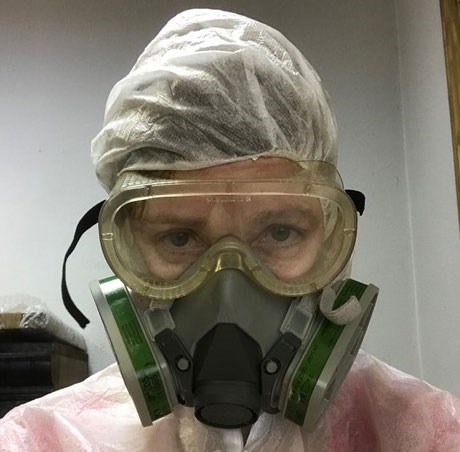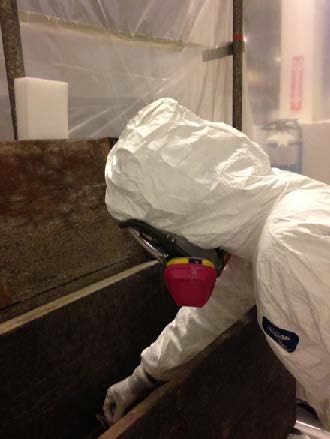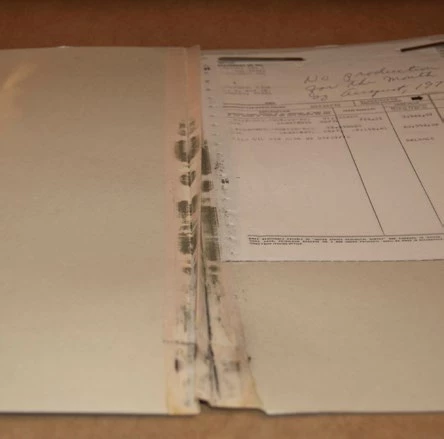Part of a series of articles titled Preservation Matters.
Article
Preservation Matters: Disasters - Mold on Cultural Resources and Collections

Mold is a type of fungus, with more than 250,000 types identified and many more yet to be classified. Mold feeds on nutritious organic materials and is integrated into the ecosystem; its primary purpose is to decompose organic materials, recycling them back into the environment.
While this is desirable in the natural environment, this decomposition is unwelcome indoors, especially in museums and library collections, which commonly contain organic materials like paper, leather, wood, and textiles. Molds excrete enzymes and acids, resulting in deterioration and staining, and can cause surface loss on valuable cultural resources as shown in the cover photo (courtesy of Mary Striegel).
Mold is easily broadcast, with spores spread through direct contact, air movement, and air handling systems, making identification of the presence of mold and immediate action critical to minimizing major mold outbreaks and preventing lasting damage to cultural collections.
SAFETY MEASURES
Take appropriate care when handling moldy materials to avoid adverse health effects.
Mold poses health hazards, depending on the type of mold and sensitivity of the individual. Mold can enter the body through inhalation and exposure to eyes. Handling moldy materials can cause short and long-term health effects. Mold exposure symptoms include hay fever-like symptoms (nasal stuffiness, eye irritation, wheezing, and skin irritation) and, in severe cases, can result in organ damage, Legionnaire’s disease, and Rhys Syndrome among others. People with allergies, immune suppression, or underlying lung disease; seniors; children; and librarians with repeated exposure will have increased sensitivities.

The use of personal protective equipment (PPE) is imperative when handling moldy materials, regardless of the extent of the mold. PPE should include a properly fit respirator or disposable N95 or N100 face masks, disposable gloves, protective goggles (without air vents), and protective clothing including hair covering with a Tyvek Bonnet or a hood from a PPE suit. Subsequently, work on moldy items should be undertaken in isolated areas, such as fume hoods, biohazard chambers, isolation rooms, or, if secure, outdoors.
Prevention
Mold can never be eliminated or eradicated; effective prevention strategies for minimiz-ing mold outbreas is accomplished through climate control, spore reduction, careful monitoring, and ongoing maintenance.

Maria Dmitrieva
Mold growth is best controlled by maintaining environmental conditions below 68°F and 55% relative humidity. Monitor for, identify, and remedy any sources of moisture or leaking water in the vicinity of cultural collections.
Change HVAC filters at least 4 times per year and after any mold outbreak, using the appropriate filter material to capture spores, which are approximately 4 – 40 microns in diameter. Check the MERV rating on filters and select the highest rating the HVAC system is capable of handling (as higher MERV ratings may restrict airflow through the air handler).
Inspect cultural collections for the presence of mold on a routine basis and immediately following any high-humidity and water disaster events of any size or origin.
Mold can be found by smell, visual examination, or mold testing with commercially available home mold test kits. Alternately, if a serious mold outbreak is suspected, mold testing can be done by a contracted professional using a polymerase chain reaction (PCR) test that can identify species.
Management
If a mold outbreak is discovered, take immediate action. Avoid expanding mold growth or cross-contamination by controlling the environment and isolating the moldy items.
- Locate the mold outbreak, identify the extent of the proliferation, and establish the urgency of response. Mold comes in many colors, textures, and dimensions. It is not necessary to identify the type of mold, but it is important to establish the extent of mold contamination, the quantity of contaminated items, and the potential for cross-contamination.
- Isolate unaffected objects or collections from contaminated objects/collections.
- Determine what can be done with available resources, including capabilities and availability of isolated work space, equipment and supplies, vendors, and/or funding.
- Designate protected work and storage spaces and monitor for moisture build-up or condensation. Plastic sheeting can be used to separate
spaces for work and storage. - Identify sources of moisture. Dry the wet space and lower the humidity quickly, consulting with building and collections specialists.
- Spores can be broadcast through a building via open windows and heating, ventilating, and air conditioning (HVAC) systems. Minimize broadcasting spores by determining the best possible airflow through windows or air handling equipment.

Treatment
Treatment options for moldy objects or collections include conservation cleaning, replacement, facsimile, and, in some instances, accepting loss.

Many treatments require conservator expertise. Damages are easily caused by improper treatment techniques or inattention, especially on mold-weakened collections. Consult with a profes-sional conservator before beginning treatment.
Mold cleaning is usually a multi-stepped process of drying, dislodging, lifting, and vacuuming spores with a HEPA filter. Additional mechanical or liquid cleaning techniques may be needed. Most commercial products (ex. Lysol and Thymol, alcohol, and bleach) are generally inadvisable for use on collections and can cause permanent damages.

During treatment, store collections in consistently cool, dry conditions to prevent further mold growth. Following treatment, complete ongoing assessments of the collections’ conditions, as mold-affected collections are vulnerable to becoming recontaminated after treatment. One hundred percent mold removal is typically unachievable since mold spores that can germinate are tiny and can hide in surface textures of objects.
While mold treatment is typically effective, there is no simple way to insure that all mold spores are removed. If the contaminated object is available in multiples, like mass produced books or textiles, it may be better to replace the object. Objects that are rare or associated with a specific person or event should be treated.
Case Study
These before and after photos show the effectiveness of vacuuming mold from a document sleeve. All visible signs of the mold were removed from the document.

JoAnne Martinez Kilgore

JoAnne Martinez Kilgore
References
-
National Park Service: NPS Primer for Disaster/Mold, https://www.nps.gov/museum/publications/primer/primintro.html
-
American Institute for Conservation (AIC): Health and Safety Wiki http://www.conser-vation-wiki.com/wiki/Health_%26_Safety
-
Mold Segment: (Video) https://www.you-tube.com/watch?v=Yq-lUdpnIuI
-
Environmental Protection Agency (EPA) Personal Protective Equipment: http://www. epa.gov/mold/moldcourse/chapter6/lesson4. html
-
Occupational Safety & Health Adminis-tration (OSHA) Mold Portal: Mold Index, http://www.osha.gov/SLTC/molds/index.html
About NCPTT
The National Center for Preservation Tech-nology and Training (NCPTT) is the leading research, technology and training center within the National Park Service.
NCPTT helps preservationists find better tools, better materials, and better approaches to conserving historic buildings and landscapes, archaeological sites, and museum collections. It conducts research and testing in its labora-tories, provides cutting edge training around the U.S., and supports research and training projects at universities and nonprofits. NCPTT pushes the envelope of current preservation practice by exploring advances in science and technology in other fields and applying them to issues in cultural resource management.
NCPTT publishes its Preservation in Practice Series to provide easily accessible guidelines for preserving cultural materials.
National Center for Preservation Technology and Training
645 University Parkway
Natchitoches, LA 71457
Website: www.nps.gov/ncptt
Phone: (318) 356-7444
Last updated: September 29, 2022
